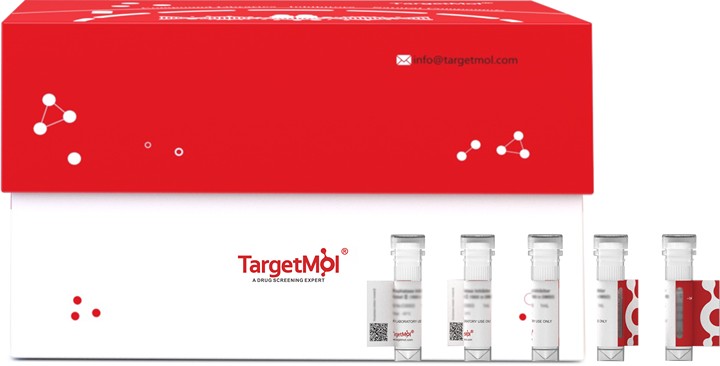 Your shopping cart is currently empty
Your shopping cart is currently empty
BioH Protein, E. coli, Recombinant (His & Myc)
The physiological role of BioH is to remove the methyl group introduced by BioC when the pimeloyl moiety is complete. It allows to synthesize pimeloyl-ACP via the fatty acid synthetic pathway through the hydrolysis of the ester bonds of pimeloyl-ACP esters. E.coli employs a methylation and demethylation strategy to allow elongation of a temporarily disguised malonate moiety to a pimelate moiety by the fatty acid synthetic enzymes. BioH shows a preference for short chain fatty acid esters (acyl chain length of up to 6 carbons) and short chain p-nitrophenyl esters. Also displays a weak thioesterase activity. Can form a complex with CoA, and may be involved in the condensation of CoA and pimelic acid into pimeloyl-CoA, a precursor in biotin biosynthesis.; Catalyzes the hydrolysis of the methyl ester bond of dimethylbutyryl-S-methyl mercaptopropionate (DMB-S-MMP) to yield dimethylbutyryl mercaptopropionic acid (DMBS-MPA) during the biocatalytic conversion of simvastin acid from monacolin J acid. Can also use acyl carriers such as dimethylbutyryl-S-ethyl mercaptopropionate (DMB-S-EMP) and dimethylbutyryl-S-methyl thioglycolate (DMB-S-MTG) as the thioester substrates.

BioH Protein, E. coli, Recombinant (His & Myc)
| Pack Size | Price | USA Warehouse | Global Warehouse | Quantity |
|---|---|---|---|---|
| 5 μg | $129 | 20 days | 20 days | |
| 10 μg | $216 | 20 days | 20 days | |
| 20 μg | $360 | 20 days | 20 days | |
| 50 μg | $543 | 20 days | 20 days | |
| 100 μg | $745 | 20 days | 20 days | |
| 200 μg | $1,070 | 20 days | 20 days | |
| 500 μg | $1,730 | 20 days | 20 days | |
| 1 mg | $2,530 | 20 days | 20 days |
Product Information
| Biological Activity | Activity has not been tested. It is theoretically active, but we cannot guarantee it. If you require protein activity, we recommend choosing the eukaryotic expression version first. |
| Description | The physiological role of BioH is to remove the methyl group introduced by BioC when the pimeloyl moiety is complete. It allows to synthesize pimeloyl-ACP via the fatty acid synthetic pathway through the hydrolysis of the ester bonds of pimeloyl-ACP esters. E.coli employs a methylation and demethylation strategy to allow elongation of a temporarily disguised malonate moiety to a pimelate moiety by the fatty acid synthetic enzymes. BioH shows a preference for short chain fatty acid esters (acyl chain length of up to 6 carbons) and short chain p-nitrophenyl esters. Also displays a weak thioesterase activity. Can form a complex with CoA, and may be involved in the condensation of CoA and pimelic acid into pimeloyl-CoA, a precursor in biotin biosynthesis.; Catalyzes the hydrolysis of the methyl ester bond of dimethylbutyryl-S-methyl mercaptopropionate (DMB-S-MMP) to yield dimethylbutyryl mercaptopropionic acid (DMBS-MPA) during the biocatalytic conversion of simvastin acid from monacolin J acid. Can also use acyl carriers such as dimethylbutyryl-S-ethyl mercaptopropionate (DMB-S-EMP) and dimethylbutyryl-S-methyl thioglycolate (DMB-S-MTG) as the thioester substrates. |
| Species | E. coli |
| Expression System | E. coli |
| Tag | N-10xHis, C-Myc |
| Accession Number | P13001 |
| Synonyms | Pimeloyl-[acyl-carrier protein] methyl ester esterase,Carboxylesterase BioH,Biotin synthesis protein BioH,bioH,bioB |
| Amino Acid | MNNIWWQTKGQGNVHLVLLHGWGLNAEVWRCIDEELSSHFTLHLVDLPGFGRSRGFGALSLADMAEAVLQQAPDKAIWLGWSLGGLVASQIALTHPERVQALVTVASSPCFSARDEWPGIKPDVLAGFQQQLSDDFQRTVERFLALQTMGTETARQDARALKKTVLALPMPEVDVLNGGLEILKTVDLRQPLQNVSMPFLRLYGYLDGLVPRKVVPMLDKLWPHSESYIFAKAAHAPFISHPAEFCHLLVALKQRV |
| Construction | 1-256 aa |
| Protein Purity | > 90% as determined by SDS-PAGE. |
| Molecular Weight | 35.9 kDa (predicted) |
| Endotoxin | < 1.0 EU/μg of the protein as determined by the LAL method. |
| Formulation | If the delivery form is liquid, the default storage buffer is Tris/PBS-based buffer, 5%-50% glycerol. If the delivery form is lyophilized powder, the buffer before lyophilization is Tris/PBS-based buffer, 6% Trehalose, pH 8.0. |
| Reconstitution | Reconstitute the lyophilized protein in sterile deionized water. The product concentration should not be less than 100 μg/mL. Before opening, centrifuge the tube to collect powder at the bottom. After adding the reconstitution buffer, avoid vortexing or pipetting for mixing. |
| Stability & Storage | Lyophilized powders can be stably stored for over 12 months, while liquid products can be stored for 6-12 months at -80°C. For reconstituted protein solutions, the solution can be stored at -20°C to -80°C for at least 3 months. Please avoid multiple freeze-thaw cycles and store products in aliquots. |
| Shipping | In general, Lyophilized powders are shipping with blue ice. Solutions are shipping with dry ice. |
| Research Background | The physiological role of BioH is to remove the methyl group introduced by BioC when the pimeloyl moiety is complete. It allows to synthesize pimeloyl-ACP via the fatty acid synthetic pathway through the hydrolysis of the ester bonds of pimeloyl-ACP esters. E.coli employs a methylation and demethylation strategy to allow elongation of a temporarily disguised malonate moiety to a pimelate moiety by the fatty acid synthetic enzymes. BioH shows a preference for short chain fatty acid esters (acyl chain length of up to 6 carbons) and short chain p-nitrophenyl esters. Also displays a weak thioesterase activity. Can form a complex with CoA, and may be involved in the condensation of CoA and pimelic acid into pimeloyl-CoA, a precursor in biotin biosynthesis.; Catalyzes the hydrolysis of the methyl ester bond of dimethylbutyryl-S-methyl mercaptopropionate (DMB-S-MMP) to yield dimethylbutyryl mercaptopropionic acid (DMBS-MPA) during the biocatalytic conversion of simvastin acid from monacolin J acid. Can also use acyl carriers such as dimethylbutyryl-S-ethyl mercaptopropionate (DMB-S-EMP) and dimethylbutyryl-S-methyl thioglycolate (DMB-S-MTG) as the thioester substrates. |
Dose Conversion
Calculator
Tech Support
| Size | Quantity | Unit Price | Amount | Operation |
|---|

Copyright © 2015-2025 TargetMol Chemicals Inc. All Rights Reserved.



